Due to a non-functioning plugin, the FB Likes disappeared 🙁 – if you like the post you can re-start the Likes all over again!Have a brand-new Like button installed!
4834 people saw it on FB
Payal Kapoor and 57 others like this on FB page Lassi with Lavina
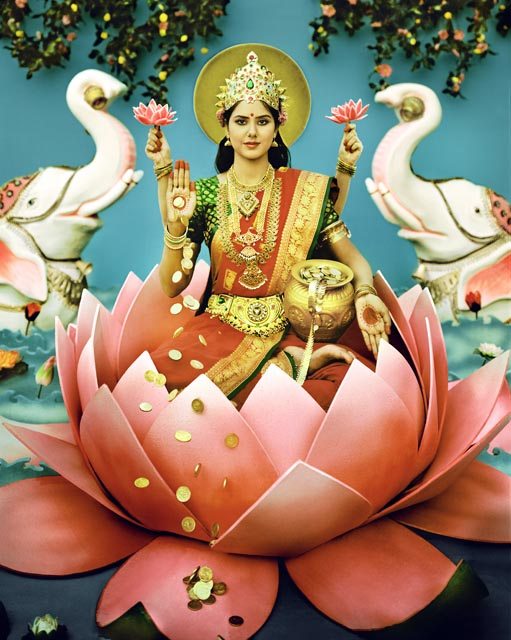
Darshan Hopping
When Hindu Gods and Goddesses Walk the Earth in our Digital Age
(Photographs – Manjari Sharma)
Goddess Lakshmi sits resplendent on a lotus; Lord Shiva strides atop a vanquished demon; there is Ma Kali, fierce and blood-thirsty, garlanded with the skulls of evil-doers; and Ganesha, calm and peaceful with a bowl of ladoos in his hand.
These are familiar images of Gods and Goddesses that Hindus have worshiped since childhood, and have seen in sacred texts, in temples, in homes, in bazaars and in calendar art.
Imagine these gigantic paintings, larger than life, in an art gallery, surrounded by votive candles, making the ambiance almost that of a temple and making these images accessible to all, believers and non-believers.
Real People or Real Gods?
Now what if I was to tell you that these are not paintings at all but life-size photographs of living human beings in the guise of Gods and Goddesses? That the ferocious Ma Kali is really an artist in real life, Hanuman is a body builder who works in a gym, Ma Saraswati is a television anchor and Lord Brahma is an architect? That Goddess Lakshmi went on to compete in the semi-finals of Miss India 2014, winning the titles of Miss Beautiful Smile and Miss Beautiful Hair?
Does that take away from the sacred context or does it enhance it? After all, Hinduism has long proclaimed the Divine within each person and explained that the human soul is but a part of the Supreme Being or Paramatma. Does that belief shine through this art, and show man’s Godliness?
We turned to the artist Manjari Sharma for the intriguing back-story on her unusual art, collectively titled ‘Darshan’. Sharma, who received a Bachelor of Fine Arts from Columbus College of Art & Design, Columbus, OH, and also studied at S.V.T. College in Mumbai, has been immersed in the art world in the West.
She explained that to create this series, she conducted exhaustive research on each god, which led to the gathering of a team of thirty-five Indian craftsmen who created props, sets, prosthetics, make-up, costumes, and jewelry to her exact specifications. The final photographs are not the result of digital manipulation but are images shot in a recreated world, almost like a film shoot. When Sharma finally looks through the lens and clicks the photograph, you get not the ordinary person – gym trainer or architect – but the transformation – the human soul as Divine Being.
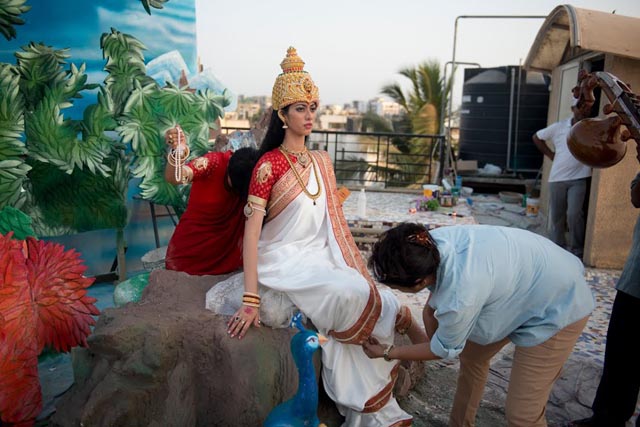
Human and Divine – God’s Leela
Through her elaborate art, you could say Manjari Sharma is imitating the grand play or Leela of the Lord, giving the role of the Almighty to the most unlikely persons. She is a long way from the temples of her youth but is creating somewhat of a temple for the uninitiated through her art. She had ‘Darshan’, a solo exhibition in 2013 at ClampArt Gallery in New York and then at Richard Levy Gallery in New Mexico this year. Her work is currently on view in Transcendent Deities of India: The Everyday Occurrence of the Divine (May 2-September 14) at Asia Society in Houston, along with the work of the noted artist Raja Ravi Varma and upcoming digital artist Abhishek Singh.
“Transcendent Deities of India features Hindu gods and goddesses depicted in the less familiar formats of photography, digital, and chromolithography which demonstrates their ongoing relevance to more recent artists who utilized the technology of their eras,” said Bridget Bray, director of exhibitions, Asia Society Texas Center.
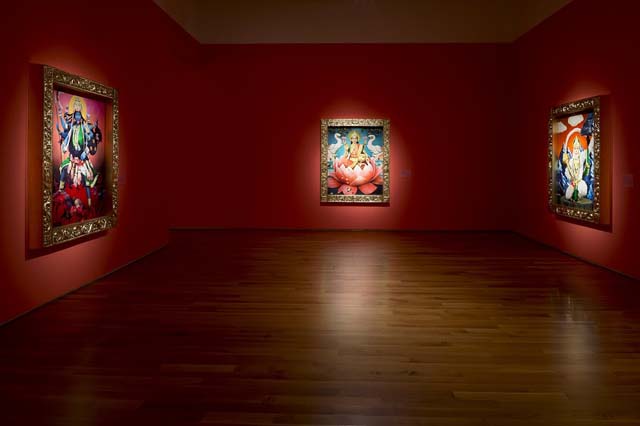
“These modern and contemporary representations of the deities preserve the tangible connection between worshippers and the objects of their reverence, which has an important religious function as well as making the works visually compelling to a broader audience.” Bray notes that religious pilgrims frequently make arduous journeys to see important depictions of deities in place at temples and other settings.
Sharma’s work has received great acclaim: it has received the 2014 Curator’s Choice Award at the Center, Santa Fe, and was selected for New York Times Portfolio Review. Both the art and Hindu worlds are recognizing the strength of these works: Sharma recently received the “Dharmic Arts Award” by the Hindu American Foundation in a Congressional building in DC.
“Manjari Sharma’s “Darshan” project, which I have awarded top honors, stood out in its appearance, inspiration, intent, and technique,” notes Malcolm Daniel, Curator of Museum of Fine Arts, Houston. “To me, these images hover between the traditional art they reference and something wholly inventive, between constructed fiction and “straight” photography, and between sincere spiritual expression and kitsch. “Darshan” is an ambitious and complex undertaking and was unique among the several hundred submissions reviewed.” Recently the Ma Saraswati photograph was acquired by the Museum of Fine Arts in Houston, Tx.
The Making of Darshan by Manjari Sharma
Spiritually Curious Souls & Project Darshan
So where did this story start? Sharma recalls her childhood days in Mumbai, where pilgrimage to various temples was an important part of her growing up days: “My mother was a spiritually curious soul and still is. There was always spiritual material floating around the house,” she says. “My dad always said Hinduism is a philosophy of life. And my mom always said it was about learning to let go and trust the universe. I always had positive associations of Hinduism as a practice because it was never a compulsion. Even at a temple, you could walk around at your pace and go explore different parts of it. My parents encouraged questions, lots of them and still do.”
Although Sharma spent her growing up years in Mumbai, she has spent the last decade in the West. She says, ” That has resulted in some incredible cultural and reverse-cultural experiences. Project Darshan, in particular, had me return to India four times within the past year and a half. I feel the work, the process is important to me. I feel that’s what Sri Krishna told Arjuna and it’s what rings true for me. The process, the philosophy, the goal is the journey and not the destination.”

Photographs as Spiritual Engagement
Indeed, Sharma’s work seems to incorporate so many different disciplines and for her photography is a license to form or find visual and conceptual relationships between related and unrelated objects, people and places: “It is a discipline that at first makes me lose myself in practice but in the end find myself in its result. My artwork is rooted in the study of relationships, personal mythology and experience. I moved from India 10 years ago and the stories I like to tell seem to address, in one way or another, the disparity between these two cultures.”
For Sharma, this project has been almost a devotion, a tapasya, creating these works from scratch, from transforming contemporary TV anchors and models into iconic depictions of a Higher Authority. What was she hoping to convey through these large scale portraits of God?
“I’m inviting the viewer to consider the photograph instead of the painting or the sculpture as a means of spiritual engagement,” she says. ” I’m also inviting the viewer to think about the idea of a Darshan and honor the power of life-altering moments.”
As she explains, usually a Darshan in Hindu Temple happens at dawn and dusk and consists of a prayer ceremony accompanied by burning lamps, echoing sounds of conch shells and wafting scents of flowers and incense. A connection with that image of a deity in the form of sculpture or painting is what a devotee comes in to experience. This experience of seeking and receiving is called a Darshan. She adds, “To me, a Darshan is a moment in which you are altered forever. A true Darshan will remain with you and burn a hole in your memory. To me life is really about going from one memorable Darshan to another.”
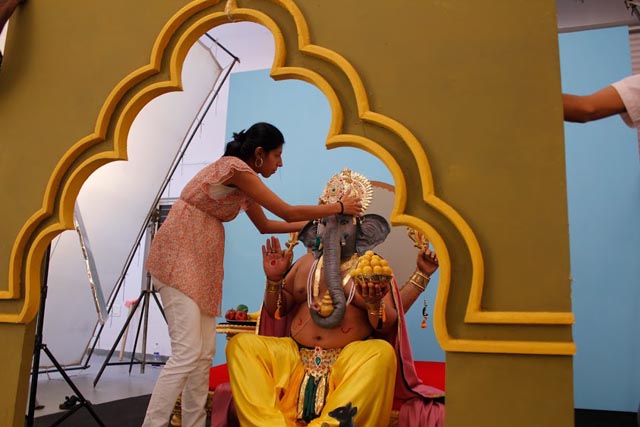
Cast and Crew create a Darshan
To create the magic of this Darshan, however, was no easy task. All the images were created in India. The plan was followed by the assembly of a crew equipped to handle the production. Four set ups were on the B.V.S.P college campus in Pune, which has a highly equipped studio. Sharma says Darshan’s collaboration was thanks to the out of the box director of the program Rajan Chaughule. The five remaining set ups were in Mumbai.
The first image was Ma Laxmi, the goddess of wealth and fortune. Recalls Sharma, “At the time I had just under 20 craftsmen that included jewelry designers, fashion stylists, make up and prop artists. Later this team eventually grew to 35 people. The production was highly involved and very meticulous. It takes usually about four weeks for a piece to come together and about a dozen pieces of film are shot. The final one that wins is always based on the expression on the character’s face.”
The hardest part was the fact that one was dealing with mortals and people management was the mantra of the day. Says Sharma, ” It was about tempering my expectation of perfection on set and communicating to people who are used to being on a film set that the final image will be a six foot tall fine art print that people will be able to inspect closely. Most craftsmen in India are used to working on what they called “mythos” which are television soaps based on Hindu scripture but it’s different when you see Ganesha for a second and then cut to a dialogue from Shiva as opposed to stare at a framed print on the wall.”
Since everyone from the models to the workers had to be paid, there was certainly a financial element to the project. Sharma funded it by an innovative and successful Kickstarter campaign and also sold prints of the artwork through her gallery. On Kickstarter, she aimed ro raise $20,000 but this intriguing project bagged her $26,000. People were lured by the innovative idea, the possibility of getting these prints – and her mom’s famous garam masala in lieu of a pledge!
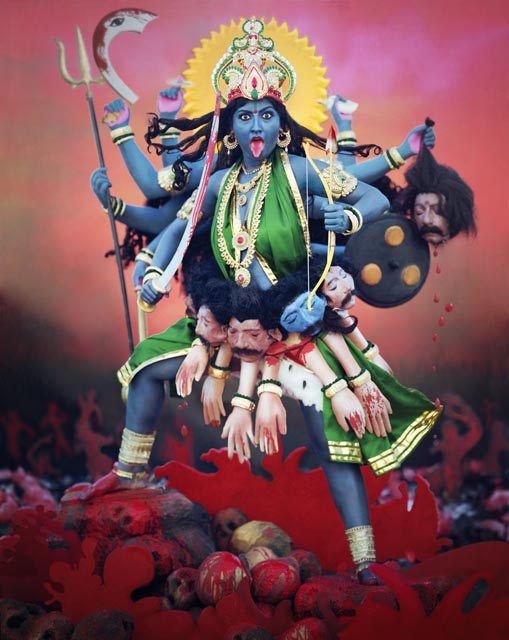
Atypical Cultural Preservation
What kind of reaction has she had from Hindus to the Darshan project? “The general audience in India is a little desensitized to the subject matter of Gods,” says Sharma. “My audience in India is someone who understands that there is a different medium employed than what their eye is used to seeing. It is someone who is conscious of the fact that this is an atypical form of cultural preservation and also, someone who appreciates the personal story that has inspired the content. There have certainly been a few art patrons from the East who have supported this project and appreciated it right from the get go.”
Indeed, viewers get to taste the other aspects of a darshan too since Sharma incorporates incense lamps, sounds from her favorite temples in Mumbai and also invocations in her mother’s voice of well-loved Sanskrit chants, all creating additional layers of memory and experience to the project.
Asked as to who her favorite deity is, Sharma points to Ma Saraswati who is the Goddess of Art, Music and Education and was the last in the series. “I had a strong connection with her and the journey was really rewarded on so many levels and when the project came to an end, I felt such a sense of belonging with her. I may have started with Ma Laxmi so I could have her blessings to proceed in the project but the goal of life is to really understand the incredible value art, music and education bring to your life. I ended my project with Ma Saraswati, a figurehead for things that have become most important to me.”
The greatest reward of this adventure with the Gods?
Says Manjari Sharma, “It was being finally able to stand in between these six-foot images and feel what I had planned as a scribble I could now see and experience coming to life.”
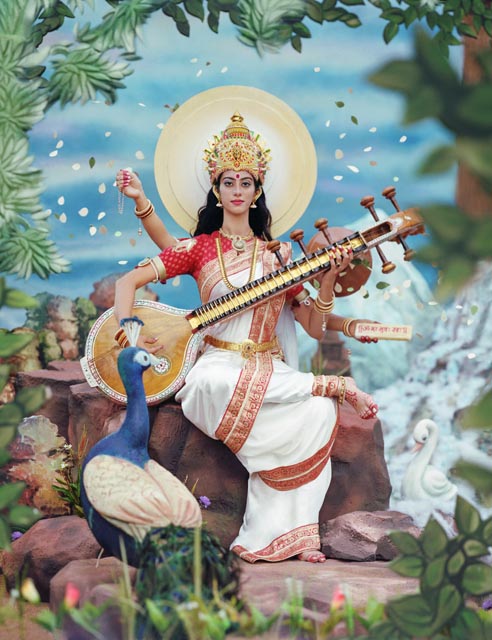

In Her Own Words
The Camera as Medium of Worship
“Having left a ritual-driven community in India, my move to the U.S. precipitated an enormous cultural shift. It was this cultural paralysis that motivated me to use my one medium of worship–the camera–to study, construct and deconstruct the mythologies of my land.
The goal was to turn multidimensional memories of sculptures and ornamental paintings of Hindu Gods, into two-dimensional photographs. For centuries, the way that we have experienced darshans (metaphysical connection established upon sight) is via laying gaze upon a molded figure, a carved statue or an illustration that represents a likeness to avatars described in Hindu scripture. This series of images invites the viewer to consider a photograph as means of spiritual engagement.
…By bridging the gap between the significant ceremonies of my parents lives and my own mythology, this series has become my reason to immerse, question and push the boundaries of my faith, not only beyond my imagination, but beyond the very frame that surrounds the photograph.”
(Artist’s statement: www.manjarisharma.com)
(This article first appeared in Hinduism Today )
(C)Lavina Melwani
Which is your favorite Hindu deity? What do you think of this concept of humans as Gods?
Related Photography Articles:
Stephen Huyler’s Daughters of India
Angry Young women, unchanging world
Gauri Gill photographs the Americans






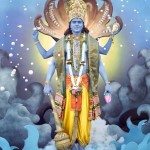
8 Comments
Sunil Yadav via Google +
It would be very interesting to visit such a gallery.
Lakshmi, so glad you enjoyed it By the way, you have a lovely name, especially lovely at Diwali time!
Awesome concept ! Thanks Lavina for posting yet another lovely article!
Via Facebook
Prem Singh Bisht
Prem sy bolo jai mata di
It is an awesome concept, Paresh but quite in keeping with Hindu philosophy which believes we, each one of us, is part of the Supreme Being.
I’m with you Ravish on this.
Awesome concept, never thought of it!
No words for divine beauty. I just bow my head.